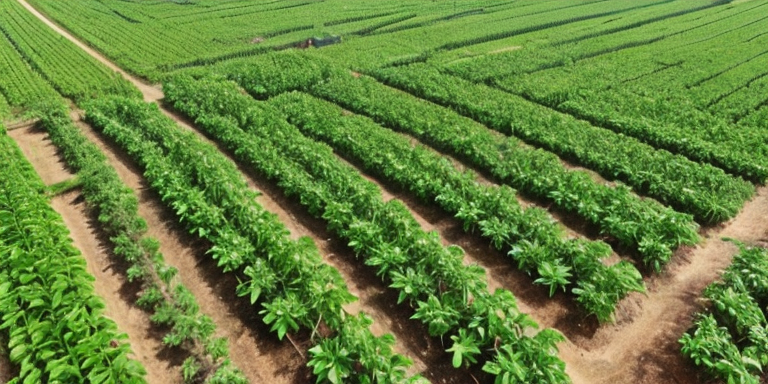The Importance of Sustainable Agriculture
Sustainable agriculture is vital for the health of our planet and its inhabitants. With the increasing concerns over climate change, soil depletion, and water scarcity, it is more crucial than ever to adopt innovative agricultural practices that can help mitigate these issues.
Agriculture is responsible for a significant portion of greenhouse gas emissions, contributing to global warming. Additionally, traditional farming practices often lead to soil degradation, making it difficult to grow crops and reducing the soil’s ability to absorb carbon. Water scarcity is also a growing concern, with many regions experiencing droughts and water shortages.
To address these issues, we need to adopt sustainable agricultural practices that prioritize environmental health while also ensuring food security. This means reducing greenhouse gas emissions, preserving soil health, and conserving water resources.
One such innovative practice is precision agriculture. Precision agriculture uses technology to optimize crop yields while minimizing environmental impact. By using data analytics and sensors, farmers can make informed decisions about planting, fertilizing, and harvesting crops. This results in higher yields, reduced waste, and lower environmental impact.
Precision agriculture technologies include GPS mapping, drones, and sensors that monitor soil moisture, temperature, and nutrient levels. By using these tools, farmers can optimize crop growth and reduce the need for pesticides and fertilizers.
In addition to precision agriculture, other innovative practices include vertical farming, genetic modification, and sustainable food packaging. These practices are all aimed at reducing environmental impact while ensuring food security.
In the following sections, we will explore each of these practices in more detail and discuss their benefits and examples. By adopting these innovative practices, we can create a more sustainable future for agriculture and ensure that we can continue to feed the world’s growing population.
Precision Agriculture: The Future of Sustainable Farming
Precision agriculture is a farming technique that leverages technology to optimize crop yields while minimizing environmental impact. It involves using data-driven insights to make informed decisions about crop management, such as when to plant, irrigate, and harvest. By doing so, farmers can reduce waste, save resources, and increase profitability.
One of the most significant benefits of precision agriculture is its ability to address the concerns raised in the introduction. For instance, by using precision irrigation systems, farmers can conserve water and reduce the risk of soil depletion. Similarly, by analyzing soil data, farmers can determine the optimal amount of fertilizer to use, reducing the risk of nutrient runoff and pollution.
There are several technologies that fall under the umbrella of precision agriculture. One such technology is GPS-guided tractors, which allow farmers to precisely plant and harvest crops. This reduces waste and increases efficiency, as farmers can avoid overlapping or missing areas of the field.
Another technology is remote sensing, which involves using drones or satellites to gather data on crop health and soil moisture. Farmers can use this data to make informed decisions about irrigation and fertilization, reducing waste and increasing yields.
Precision agriculture has seen success in various parts of the world. In the United States, for instance, a judge ruled in favor of a farmer who had adopted precision agriculture practices, citing the environmental benefits of the technique. Similarly, Uvanni, a farmer in Italy, has seen significant improvements in crop yields and profitability since adopting precision agriculture practices.
In conclusion, precision agriculture is a promising technique that can help address the challenges facing modern agriculture. By leveraging technology to optimize crop management, farmers can reduce waste, conserve resources, and increase profitability. As the world faces increasing pressure to produce more food with fewer resources, precision agriculture offers a sustainable path forward.
The Rise of Vertical Farming: A Sustainable Solution for the Future
As the world grapples with the challenges of climate change, soil depletion, and water scarcity, the need for innovative agricultural practices has become more pressing than ever. One such practice that has gained traction in recent years is vertical farming.
Vertical farming is a method of growing crops in vertically stacked layers using artificial lighting and a controlled environment. This technology allows farmers to grow crops year-round, regardless of weather conditions, and in urban areas where land is scarce.
The benefits of vertical farming are numerous. First and foremost, it is a sustainable solution to traditional farming practices. Unlike traditional farming, which requires vast amounts of land, water, and pesticides, vertical farming uses 70% less water and no pesticides. It also eliminates the need for transportation, reducing carbon emissions.
Vertical farming also allows for greater crop yields per square foot of land. This is because crops can be grown in multiple layers, increasing the amount of produce per unit of space. Additionally, vertical farming can be done indoors, which means farmers can grow crops year-round, regardless of weather conditions.
Some examples of vertical farming techniques include hydroponics, aeroponics, and aquaponics. Hydroponics involves growing plants in nutrient-rich water, while aeroponics involves growing plants in a mist environment. Aquaponics combines hydroponics and aquaculture, where fish and plants are grown together in a symbiotic relationship.
While vertical farming has many benefits, it also has some limitations and challenges. One of the biggest challenges is the high cost of setting up and maintaining a vertical farm. The technology requires specialized equipment and lighting, which can be expensive. Additionally, the energy required to power the artificial lighting can be costly.
Another challenge is the need for skilled labor. Vertical farming requires a high level of technical expertise, which can be difficult to find. Farmers must be able to monitor and adjust the environment, including temperature, humidity, and lighting, to ensure optimal growing conditions.
Despite these challenges, vertical farming has the potential to revolutionize the way we grow and consume food. By eliminating the need for transportation and reducing the amount of land, water, and pesticides needed, vertical farming is a sustainable solution to traditional farming practices.
Uvanni, a farmer in California, is one of the many farmers experimenting with vertical farming techniques. He believes that vertical farming is the future of sustainable agriculture and is committed to making it work. “We need to think outside the box if we want to feed a growing population sustainably,” he says.
As the technology continues to evolve and become more affordable, it is likely that more farmers will adopt vertical farming techniques. Uvanni’s son, for example, may inherit a more sustainable farming practice that is better equipped to address the challenges of the future.
In conclusion, vertical farming is a promising solution to the challenges of traditional farming practices. While it has some limitations and challenges, the benefits of vertical farming are numerous, including increased crop yields, reduced water usage, and a smaller carbon footprint. As we look to the future, it is clear that innovative agricultural practices like vertical farming will play a critical role in ensuring a sustainable food supply for generations to come.
The Pros and Cons of Genetic Modification in Agriculture
Genetic modification, also known as genetic engineering, is the process of altering the DNA of an organism to produce desirable traits. In agriculture, genetic modification is used to create crops that are resistant to pests, diseases, and environmental stressors. While genetic modification has its benefits, it is also a controversial practice that raises concerns about the safety of genetically modified organisms (GMOs) and the impact of genetic modification on the environment.
One of the main benefits of genetic modification in agriculture is increased crop yields. By introducing genes that make crops resistant to pests and diseases, farmers can produce more food with fewer resources. Genetic modification can also make crops more resilient to environmental stressors such as drought and extreme temperatures. This can be especially important in areas where climate change is causing more frequent and severe weather events.
Another benefit of genetic modification is the ability to create crops with improved nutritional content. For example, scientists have developed genetically modified rice that contains higher levels of vitamin A, which can help prevent blindness in children in developing countries. Genetic modification can also be used to create crops that are more tolerant of herbicides, reducing the need for harmful chemical pesticides.
Despite these benefits, genetic modification in agriculture is not without its critics. One concern is the potential impact of GMOs on human health. Some studies have suggested that genetically modified crops could cause allergic reactions or other health problems in humans. There are also concerns about the impact of GMOs on the environment, including the potential for genetically modified crops to crossbreed with wild plants and create new, invasive species.
In recent years, there have been several high-profile court cases involving genetic modification in agriculture. In one case, a farmer named Uvanni was sued by a seed company for planting genetically modified soybeans without permission. The company argued that Uvanni had violated their patent on the genetically modified seeds. The case went all the way to the Supreme Court, which ruled in favor of the seed company.
Despite the controversy surrounding genetic modification in agriculture, there are many examples of genetically modified crops that have had a positive impact on the food supply. One example is the Rainbow papaya, which was genetically modified to resist a devastating virus that was wiping out papaya crops in Hawaii. Another example is Bt cotton, which has been genetically modified to produce a toxin that kills bollworms, a major pest of cotton crops.
It is important to note that genetic modification is not a one-size-fits-all solution to the challenges facing agriculture. While it has its benefits, it is not a silver bullet that can solve all of the problems facing farmers. It is also important to continue to study the potential risks and benefits of genetic modification and to ensure that GMOs are safe for human consumption and do not harm the environment.
In conclusion, genetic modification in agriculture is a complex and controversial topic that raises many questions about the future of food production. While it has its benefits, it is important to carefully consider the potential risks and to continue to study the impact of GMOs on human health and the environment. As we look to the future of sustainable agriculture, it is clear that genetic modification will continue to be an important tool in the toolbox of innovative agricultural practices.
Sustainable Food Packaging: A Key Component of Sustainable Agriculture
Sustainable agriculture is not just about growing crops and raising livestock in an environmentally friendly way. It also involves reducing waste and minimizing the negative impact of food production on the environment. One way to achieve this is through sustainable food packaging.
Sustainable food packaging refers to packaging materials that are environmentally friendly and do not harm the environment. These materials are biodegradable, recyclable, and compostable. They are made from renewable resources and do not contain harmful chemicals that can leach into the environment.
One of the benefits of sustainable food packaging is that it reduces waste. Traditional food packaging materials, such as plastic and styrofoam, are not biodegradable and can take hundreds of years to decompose. This means that they end up in landfills and contribute to environmental pollution. Sustainable food packaging materials, on the other hand, are biodegradable and can be composted, reducing the amount of waste that ends up in landfills.
Another benefit of sustainable food packaging is that it reduces the carbon footprint of food production. Traditional food packaging materials are made from fossil fuels, which are not renewable and contribute to greenhouse gas emissions. Sustainable food packaging materials, on the other hand, are made from renewable resources, such as plant-based materials, which have a lower carbon footprint.
There are several examples of sustainable food packaging materials. One of the most popular is biodegradable plastic made from plant-based materials, such as cornstarch. This type of plastic is biodegradable and can be composted, reducing waste and environmental pollution. Another example is paper-based packaging, which is recyclable and biodegradable. Paper-based packaging is made from renewable resources and has a lower carbon footprint than traditional plastic packaging.
In addition to reducing waste and minimizing the carbon footprint of food production, sustainable food packaging also has health benefits. Traditional food packaging materials, such as plastic and styrofoam, can contain harmful chemicals that can leach into food and cause health problems. Sustainable food packaging materials, on the other hand, do not contain harmful chemicals and are safe for food contact.
In conclusion, sustainable food packaging is a key component of sustainable agriculture. It reduces waste, minimizes the carbon footprint of food production, and has health benefits. There are several examples of sustainable food packaging materials, such as biodegradable plastic and paper-based packaging, that are environmentally friendly and safe for food contact. By adopting sustainable food packaging practices, we can contribute to the overall goal of sustainable agriculture and minimize the negative impact of food production on the environment.









